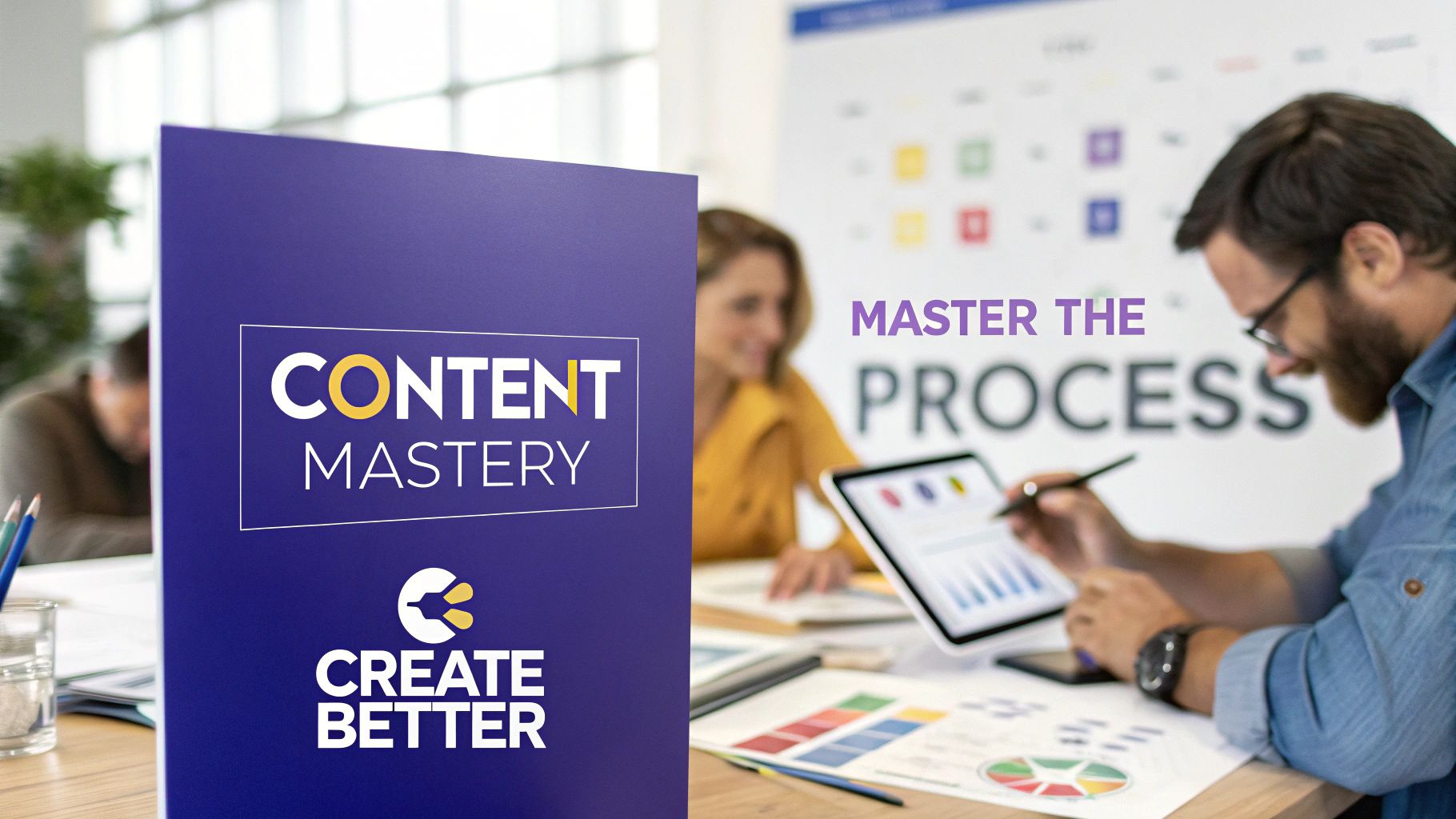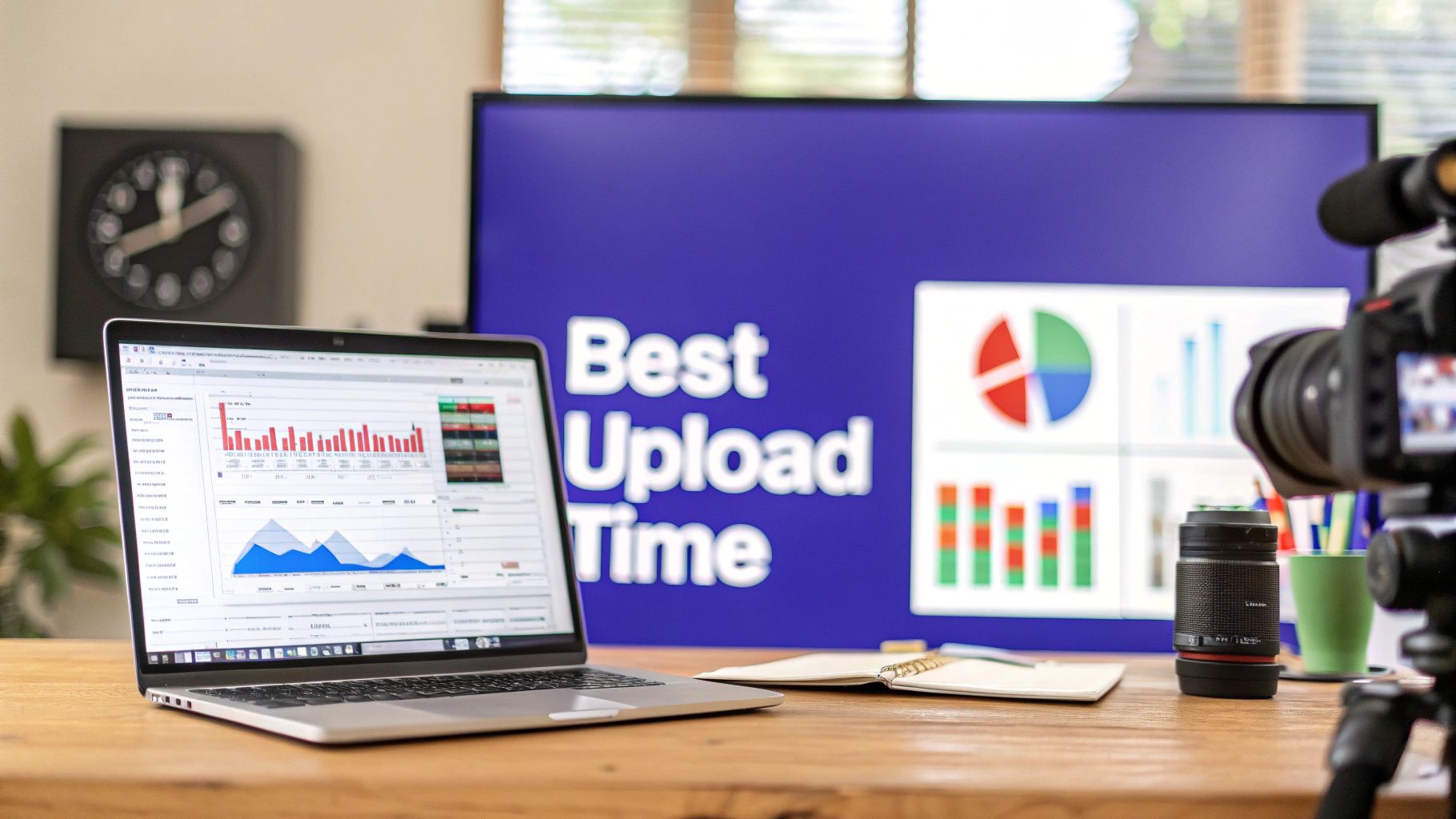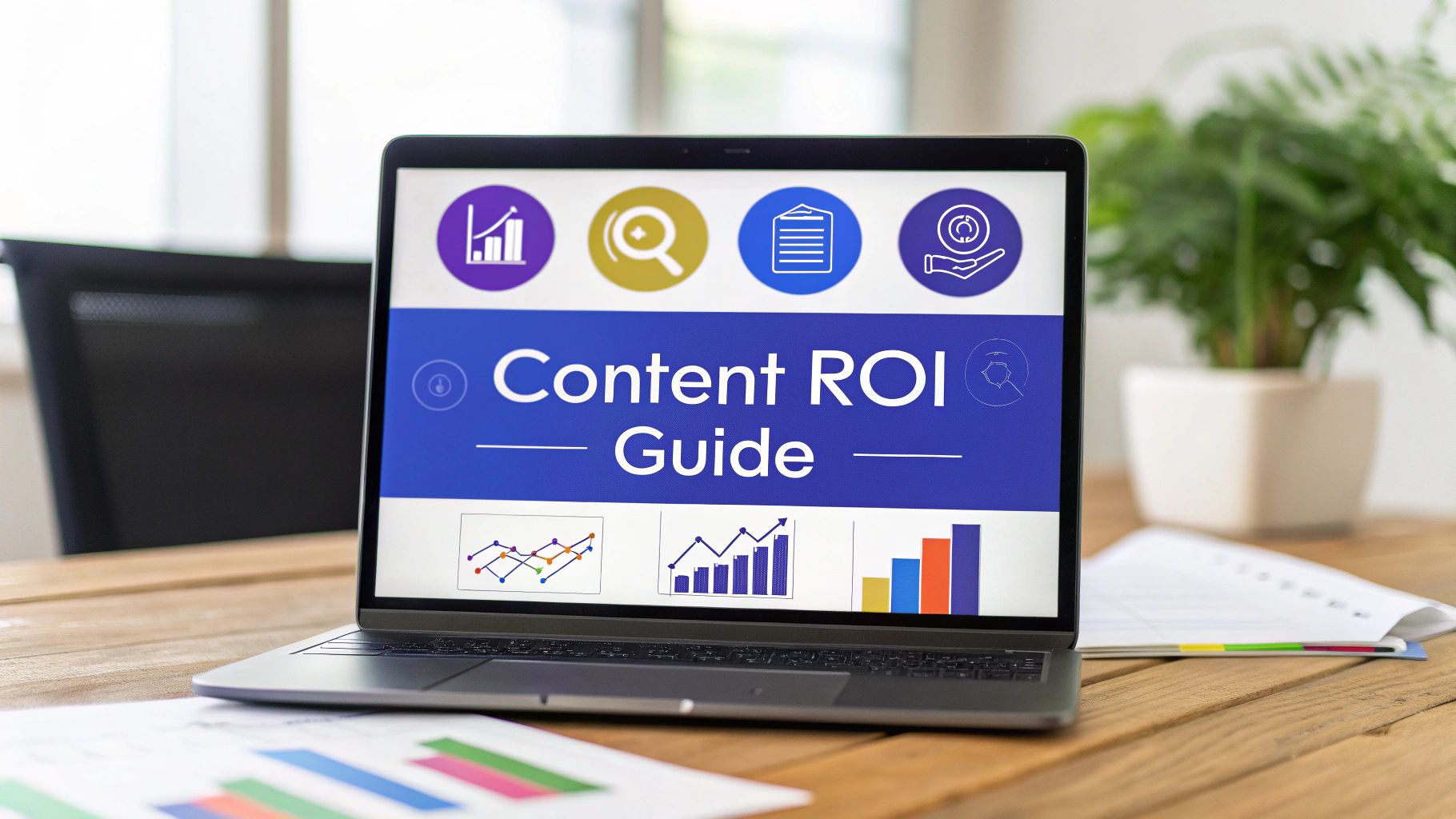Let’s be honest—jumping from a great idea to a published social media post often feels chaotic. Without a clear game plan, it's easy for marketing teams and creators to get lost in the weeds, producing content that's inconsistent and, frankly, doesn't hit the mark.
This is where a solid content creation process comes in. It’s more than just a to-do list; it’s your roadmap for turning scattered ideas into high-quality, impactful content that actually supports your business goals. It's about replacing guesswork with a reliable system.
Your Framework For Better Content Creation
Think of a structured workflow as your strategic guide. It’s a repeatable framework built on four core phases that we'll dive into: Strategic Planning, Hybrid Creation, Collaborative Refinement, and Intelligent Distribution. Adopting this system is how you ensure every single piece of content you create is intentional and aligned with what your brand is trying to achieve.
Start With a Strategic Foundation
Before you even think about writing a caption or picking out a graphic, you need to anchor your efforts in strategy. This is the phase that stops you from creating content in a vacuum. It’s all about figuring out your direction first.
This process flow shows you exactly how those foundational pieces fit together, moving from big-picture ideas to a sharp focus on your audience.
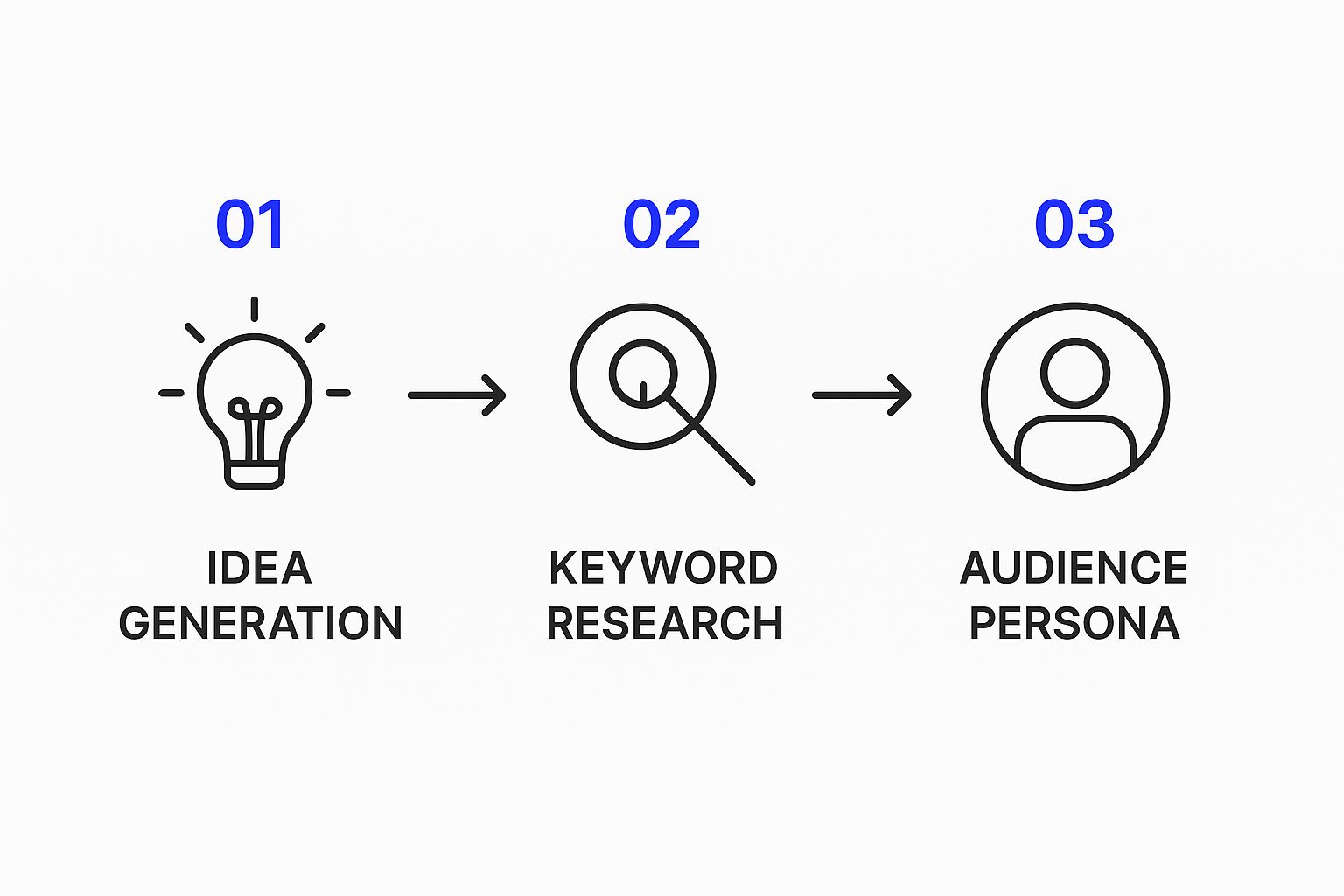
As you can see, great content starts with brainstorming, gets validated with solid keyword research, and is then laser-focused to meet the specific needs of your audience. Following this path is what makes your content not just creative, but discoverable and genuinely useful.
The Four Pillars of an Effective Workflow
A modern content workflow isn't a one-way street from creation to posting. It’s a cycle. Each phase feeds into the next, creating a loop of constant improvement that helps you work smarter, not harder.
Breaking the process down into these four pillars allows teams to operate much more efficiently and pump out better content, consistently. Of course, weaving in proven content marketing best practices is what will really give your framework a professional edge.
The modern content creation workflow is built around four distinct yet interconnected phases. Understanding the role of each one is crucial for developing a system that is both efficient and effective.
Core Phases of the Modern Content Workflow
| Phase | Objective | Key Activities |
|---|---|---|
| Strategic Planning | To define the "why" and "who" behind your content. | Setting goals, identifying target audiences, brainstorming topics, and conducting keyword research. |
| Hybrid Creation | To bring ideas to life using a mix of human and AI tools. | Drafting copy, designing visuals, producing videos, and assembling post components. |
| Collaborative Refinement | To ensure quality, accuracy, and brand alignment. | Proofreading, fact-checking, team feedback loops, and final approvals. |
| Intelligent Distribution | To maximize reach and impact. | Scheduling posts, cross-channel promotion, and analyzing performance data. |
By treating these phases as a cohesive system, you ensure that every piece of content is purposefully planned, creatively executed, thoroughly vetted, and strategically delivered.
Here’s a closer look at what each pillar involves:
Strategic Planning: This is where you answer the big "why." You’re setting clear goals, figuring out exactly who you're talking to, brainstorming relevant topics, and digging into keyword research to see what your audience is actually looking for.
Hybrid Creation: Now the ideas become real. This phase is all about blending human creativity with the efficiency of AI-powered tools like PostSyncer. You can draft copy, design visuals, and even produce video content much faster this way.
Collaborative Refinement: I can't stress this enough: no content should go live without a second set of eyes. This stage is for proofreading, fact-checking, and getting feedback from your team to nail the quality and make sure it’s on-brand.
Intelligent Distribution: Creating brilliant content is half the battle; people need to see it. This final phase covers everything from scheduling posts for peak engagement times to promoting your content across different channels and, crucially, analyzing how it performed to make your next strategy even better.
Laying the Foundation for Your Content Strategy

Great content never just happens. It’s always the result of a smart, well-defined strategic plan. This is the part where you connect every creative idea to real business goals, transforming random posts into a campaign that actually drives results. Honestly, this is the single most important part of the content creation process.
When you skip this step, content tends to feel disconnected and just doesn't land with your audience. A solid plan makes sure every single post, video, or story has a clear job to do.
Get Laser-Focused on Your Audience
Vague personas just don't cut it anymore. "Millennial entrepreneurs" is a starting point, but we need to go deeper. Who are they really?
Think about it this way: instead of a broad label, picture a "28-year-old SaaS founder in Austin who's struggling with lead generation and binge-watches tech influencer content on LinkedIn." See how much easier it is to create content that speaks directly to their problems?
To get this sharp focus, you need to dig into:
- Demographics: Sure, age and location matter. But what's their job title? Their income level? These details shape their worldview.
- Pain Points: What are the specific problems that keep them up at night? The ones your product or service is built to solve.
- Online Behavior: Where do they hang out online? Which platforms do they use for work versus for fun? What kind of content actually makes them stop scrolling?
Nailing these details is what turns your content from a generic broadcast into a meaningful conversation.
Set Clear, Measurable Goals
Your content needs a purpose. Goals like "increase brand awareness" sound nice, but they're nearly impossible to measure and prove. Instead, you need to tie your efforts to specific, quantifiable business outcomes.
The Content Marketing Institute found that 77% of marketers agree that interactive content can have reusable value, leading to repeat visitors. This is a perfect example of how a specific content type can directly support a measurable goal like increasing engagement.
The best goals are always SMART: Specific, Measurable, Achievable, Relevant, and Time-bound. For instance, a great goal isn't just "get more leads." It's "increase qualified leads from Instagram by 15% in Q3." Or maybe, "boost video engagement rate on YouTube Shorts by 20% over the next 60 days."
When you have targets this clear, it makes brainstorming topics a breeze and helps you prove the value of your social media efforts down the line.
Brainstorm Topics That Genuinely Help
Now that you know who you're talking to and what you want to achieve, it's time for the fun part: ideation. The sweet spot for content ideas is always at the intersection of what your audience needs and what your brand is an expert in.
Use keyword research and trend analysis tools to find out what people are actively searching for. Even better, look for the questions people are asking in forums, social media comments, and on blogs in your niche. These are content goldmines. If you see people constantly asking about scheduling tools, a post comparing different workflow options is a no-brainer.
Putting together a full-blown strategy can feel like a huge task, but breaking it down into these pieces makes it totally manageable. If you want a head start, check out our detailed guide on building a social media marketing plan template. It gives you a structure for organizing all these strategic elements, ensuring your team is aligned and your publishing schedule is consistent.
Fusing AI and Human Creativity for Content
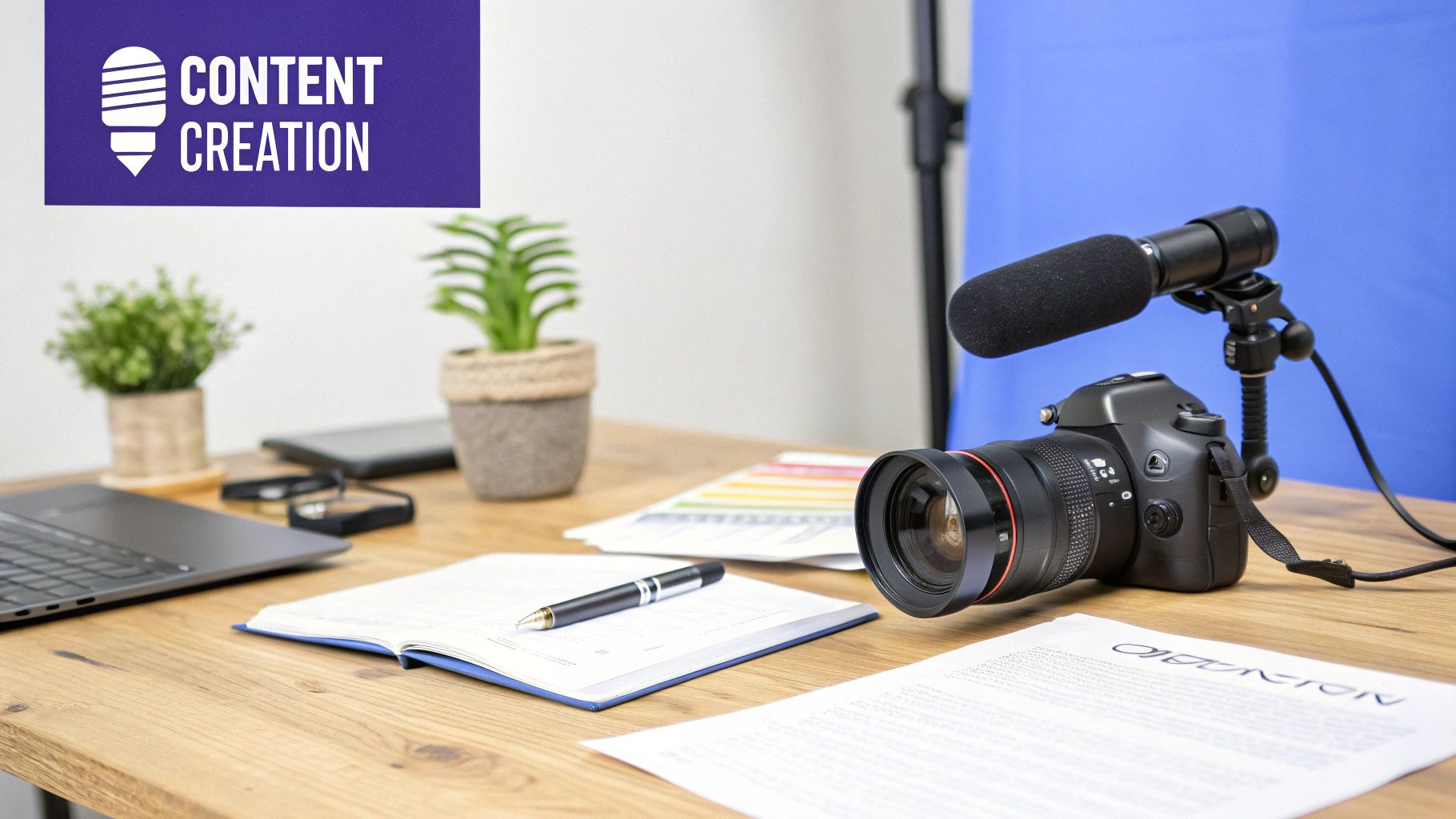
This is where your strategy gets real and your ideas turn into actual posts. The modern way to create content isn't a battle of human versus machine. It’s about creating a powerful partnership between them. The goal is simple: combine the raw speed and data-crunching ability of AI with the irreplaceable nuance, personality, and emotional intelligence that only a human can provide.
Think of AI as your creative sidekick. It’s fantastic at demolishing writer's block. It can spit out first drafts, brainstorm a dozen post ideas in seconds, or find new angles on a tired topic. This completely changes the game, cutting down the time spent on the initial grind of creation.
Accelerating Ideation with AI
Let's be real—staring at a blank page is the worst. Instead of waiting for inspiration to strike, you can use tools like PostSyncer’s AI Content Studio to kickstart your entire workflow.
For instance, you could give it a simple prompt: "Generate five Instagram post ideas for our coffee shop's new pumpkin spice latte." In just a few moments, you’ll have a list of potential hooks, captions, and calls to action ready to go. You've just gone from zero to a solid starting point in less time than it takes to brew a cup of coffee.
The real magic of AI here isn’t about replacing your creativity, but about amplifying it. It does the heavy lifting, freeing you up to focus on the high-level strategy and refinement that truly make content great.
This kind of speed is becoming non-negotiable. The digital content creation market is exploding, with revenues expected to jump from $27.1 billion in 2023 to $34.5 billion by 2025. Efficient workflows are the only way to keep up.
The Irreplaceable Human Touch
AI brings the speed, but you bring the soul. No algorithm, no matter how sophisticated, can truly replicate your brand’s unique voice, your inside jokes with your audience, or the genuine emotional connection you’ve built. This is where you, the human expert, are absolutely essential.
Your role shifts. You're no longer just a writer starting from scratch; you're a strategic editor, a brand guardian, and a storyteller. You take the foundation the AI gives you and build something uniquely yours on top of it.
This means you'll be:
- Refining the Tone: Tweaking the AI’s output until it sounds exactly like you—whether that’s witty, professional, or deeply inspiring.
- Ensuring Authenticity: Weaving in personal stories, specific customer examples, or unique insights that an AI could never dream up.
- Fact-Checking: Double-checking every stat, claim, and piece of data to maintain the trust you've worked so hard to build.
If you want to go deeper on picking the right AI tools to fit into your process, a good AI writing assistant guide can be a massive help in sorting through the options.
Weaving It All Together
When you get this hybrid workflow right, you create a system that produces content that is both efficient to make and genuinely connects with people. It’s a core piece of any successful social media plan. To see how this fits into the larger puzzle, check out our complete guide on building a winning social media content strategy.
By mastering this blend of machine efficiency and human creativity, you’re not just making posts—you’re building a scalable content engine that consistently delivers quality.
A great idea is just the starting point. To turn that raw draft into a polished, on-brand post, you need a solid review and approval workflow. It’s the critical step where good content becomes great content, ready to make an impact.
Think of it as your internal quality control. Skipping this phase is like trying to build a house without inspecting the foundation—even the best ideas can crumble under the weight of a simple typo, a broken link, or a tone that just feels off.
Getting Your Feedback Loop Right
An effective review process is so much more than just a spell-check. It’s about building a clear path for a post to travel from its first draft to final sign-off, making sure every piece is fact-checked, on-brand, and optimized for its destination.
This is where a tool like PostSyncer really shines. Instead of messy email threads or lost Slack messages, you can leave precise comments right on the draft. You can tag the designer to get their eyes on a graphic or loop in your manager for a final once-over, all in one place. It keeps everyone accountable and the whole process moving smoothly.
For instance, a social media manager can draft a post promoting a new feature, then tag someone from the legal team for a quick compliance check. Once they give the thumbs-up, the manager can tag a senior marketer for a final brand voice review. It’s a clean, traceable workflow.
A strong review process is what separates the amateurs from the pros. It’s the safety net that protects your brand’s reputation and ensures consistency with every single thing you publish.
And in today's world, that professional touch is non-negotiable. The creator economy has absolutely exploded since 2020, with over 165 million people now creating content. With 2 in 10 creators now running their own content-based businesses, the bar for quality has been set incredibly high. A rigorous review process isn't just a nice-to-have; it's essential to even compete. You can explore more on the growth of the creator economy and what it means for professionals.
The Real Payoff of a Collaborative Workflow
Beyond just catching mistakes, a truly collaborative review process makes your entire team smarter and your content stronger. When you invite different experts to weigh in, the end result is almost always better for it.
Here’s what that looks like in practice:
- Fresh Perspectives: A sales lead might spot a customer pain point you hadn't considered, while your designer can suggest a simple visual tweak that makes the post 10x more engaging.
- Built-in Mentorship: Junior team members get to learn directly from senior feedback, which raises the skill level and confidence of the whole team over time.
- A Truly Consistent Voice: It’s the single best way to make sure every post sounds like it came from one cohesive brand, no matter who originally wrote it.
This is your last chance to refine, improve, and perfect your work before it goes out into the world. By putting a robust and collaborative review workflow in place, you’re guaranteeing that every piece of content you share is something your entire team can stand behind.
Distributing Your Content for Maximum Impact

Look, creating a fantastic piece of content is a huge win. But popping the champagne after you hit "save" is premature. Your work is only half done.
The final, and arguably most critical, phase is getting that content in front of the right eyeballs at the right time. This is where strategic distribution turns your creative efforts into real, measurable results. A solid distribution plan is what separates content that just sits there from content that actually performs.
Automate Your Schedule for Consistency
If you’re still manually posting to all your social accounts one by one, you’re burning time you don’t have. It's a surefire way to be inconsistent and, eventually, burn out. For any serious creator or marketing team, using a top-tier scheduling tool like PostSyncer isn't just a nice-to-have; it's essential.
It lets you set up your entire publishing calendar on autopilot, freeing you up to focus on the bigger picture—strategy, engagement, and what to create next.
For example, you can dedicate a few hours to batch-create a week's worth of content, load it into your calendar, and trust the tool to get it live. This ensures a consistent stream of posts, even when you're swamped. That consistency is exactly what keeps you top-of-mind with your audience. If you need a hand getting organized, our guide on how to create a social media calendar is the perfect place to start.
Tailor Your Content for Each Platform
I see this mistake all the time: copying and pasting the exact same message across every network. Please don’t do this. Every platform has its own unique vibe, its own unwritten rules, and its own audience expectations.
A professional, text-heavy post that gets tons of engagement on LinkedIn is going to fall completely flat on a visually-driven platform like Instagram.
Effective distribution means speaking the native language of each platform. It’s about adapting your core message to fit the format and user behavior specific to that channel.
Here’s a quick-and-dirty breakdown of how you might adapt one core idea:
- For Instagram: It's all about the visual. Start with a stunning image or a snappy Reel. The caption needs to be compelling, with a clear call-to-action and a smart mix of popular and niche hashtags.
- For LinkedIn: Go for an authoritative, insightful take that sparks a professional conversation. Tagging relevant companies or thought leaders can give your visibility a serious boost.
- For Facebook: This is where you can be more conversational. Ask questions to get the comments rolling or even create a poll to drive up that sweet, sweet interaction.
Pinpoint Your Optimal Posting Times
Posting when your audience is actually online and scrolling can make a world of difference. It can be the one thing that pushes your content from getting a few likes to going viral.
So, how do you find these magical time slots? You dig into your analytics.
The best way to nail your timing is to stop guessing and start looking at the data. PostSyncer's analytics tools, for example, can show you exactly when your followers are most active and engaging with your posts. You might find out your audience is all over your content during their weekday lunch break or scrolling late on Sunday nights. Scheduling your most important posts for these peak windows is a simple, powerful way to cut through the noise.
Have a Few Questions? We’ve Got Answers.
Even with the best game plan, questions always come up when you're dialing in your workflow. We get it. Here are some of the most common things people ask us about building a better content creation process.
What Is the Most Important Part of the Content Creation Process?
Honestly, while every step matters, your initial strategic planning is where the magic really happens. Without a solid strategy, you're just creating content for the sake of it, hoping something sticks. That's a recipe for burnout.
This is the stage where you get crystal clear on who you're talking to, what you want to achieve, and how your content will actually help your business. Nailing this foundation means every post, video, or story has a purpose. It's the difference between randomly throwing darts and hitting a bullseye every time.
How Can I Speed Up My Content Workflow Without Sacrificing Quality?
This is the million-dollar question, isn't it? The secret is to stop thinking about it as AI versus human and start thinking of it as AI and human. It’s a partnership. Use smart tools like PostSyncer to do the heavy lifting—like brainstorming first-draft ideas or generating a bunch of post variations.
This frees you and your team up for the work only humans can do.
By letting AI handle the grunt work, you can pour your energy into the strategic stuff: injecting your unique brand voice, sharing real stories, and making sure the content actually connects with people. You maintain incredibly high quality while slashing your production time.
You're not just a content creator anymore; you become a director. You’re working smarter, using tech as a creative partner to get more done without spreading yourself too thin.
How Often Should I Review and Update My Content Creation Process?
Things move fast online, so your process can't be set in stone. As a general rule, a deep-dive review every quarter is a great habit to get into. But don't wait three months if something feels off. Be ready to make small tweaks monthly or even weekly based on what the data and your team are telling you.
A process that was perfect six months ago might have a few cracks in it today.
Here are a few signs that it’s time for a check-up:
- Your numbers are dipping. If engagement or reach is trending down, it's a clear signal to reassess what you're doing and why.
- Your team is hitting roadblocks. Listen to the people in the trenches. If they're frustrated or stuck, their feedback is gold for finding and fixing inefficiencies.
- The landscape changes. When a platform like Instagram rolls out a new feature or you bring a new tool into your stack, you’ll need to adjust your workflow to make the most of it.
Regular check-ins keep your process from getting stale and ensure you’re always operating at peak efficiency.
Ready to build a smarter, faster content creation process? With PostSyncer, you can plan, create, collaborate, and schedule all your social media content from one central hub. Stop juggling chaotic workflows and start producing high-impact content with ease. Start your free 7-day trial of PostSyncer today.
